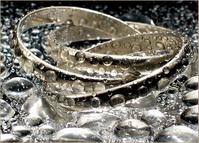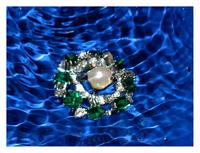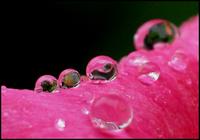Travel all seven seas, cruise the Mediterranean, and back again right from your computer, simply by clicking on our Flickr page.
At WaterWideWeb, we’re using social media tools to raise awareness about the importance of protecting and sustaining the world’s water resources.
Check out The Photo Journal of an Oregonian, which features pristine lakes and ponds in the Pacific Northwest.
You can also enjoy phenomenal shots of underwater life and coral reefs in the album Panama ICBG Program. This entire set of photographs was shared with WaterWideWeb by lead investigators in the Panama International Cooperative Program working on drug discover in Panama.
Currently, we have over 300 member in our Flickr Group, and we anticipate that these numbers will grow exponentially in the coming weeks.
Help us raise awareness about the significance of water resource stewardship. Join us on Flickr! Engage in discussion with professionals from around the world who are donating their artwork to make a stand about appropriate water stewardship.
Statistics and estimates about water insecurity can be mind numbing to some people. That’s why we are using creative art to reach all members of our readership.
A picture is worth a thousand words. And a good one, could be mean a thousand more supporters for the sustainable use of the world’s water resources.
If you would like to submit photographs for publication on WaterWideWeb’s Flickr account, please email photos and appropriate credits to: [email protected]
The photograph above was taken by one of WaterWideWeb’s biggest supporters, Daniel Graff
If you enjoyed this article, you should also read:
Water for Steamy Hot Cocoa: Hot or Not?
Style Your Kitchen and Bath Sustainably
D.J. Knowles Releases Hot New Track for H20 Charity
]]>The photograph to the top right is a magnificent shot of Mento’s hand sprinkled with droplets of water from the Nile River in Africa. As Mento dips his hand into the water of the world’s longest river, one asks, “Will there come a day, when every hand of every member of the African Diaspora can feel the gentle rush of the Nile River?”
This photograph reminded Mento of the famous poem, “The Negro Speaks of Rivers” by renowned African-American poet, Langston Hughes. In the poem, Hughes reflects on his intimate familiarity with the River Euphrates in Asia, The Nile River in Africa, and the Mississippi River in the United States.
Throughout the work, Hughes alludes to the African-American experience with respect to rivers. At the conclusion of the poem, Hughes writes, “My soul has grown deep like the rivers.” Mentos’ life parallels the poem by Hughes. He was born in Ghana, along the west coast of Africa. Now, he resides in New York City, close to the historic Hudson River.
Mento is well acquainted with the flow of rivers and water. He knows life along the banks of rivers in different parts of the world. And his photography is evidence of that.
In the photograph to the left, Mento captures a boy fishing in Ghana. The picture is taken in black and white versus color like the other photos that Mento provides. Ironically, the boy’s shirt reads “Bad Boy”. But one looks at this picture and sees everything but a bad boy. The youth’s hands are full of fishing equipment. Waves crash in the distance. But, there are no fish in his hands.
Life along this river is very different than life along other rivers. For this young boy, the water is a source of food and most likely income as well. This picture shows the importance of the water on life for the young boy. Is his fishing journey just beginning or is he returning home? Mento leaves viewers with innumerable questions with this intriguing photograph.
The photograph to the bottom right was taken from Mento’s collection of photos from a recent visit to Ghana. Waves crash onto the shores of a sandy beach. There’s a single set of footprints in the sand and one wonders who walked along this beautiful beach? Was he or she tempted to swim in the beautiful ocean? Or did he or she prefer to leave the majestic beauty of the ocean tide undisturbed?
The work of Les Mento touches upon history and modern life along the world’s rivers. His creative references to literature and culture engage viewers on an artistic excursion that surpass a mere glimpse at a still image. Mento draws parallels between history, art, and culture in his work. With a click of his camera, onlookers sojourn from the shores of the Nile River, to the coastline of Ghana and back again.
If you enjoyed this article, you should also read:
Water and Art: The Work of Diane Churchill
Water and Art: The Work of Sonni Suryatmojo
]]>Suryatmojo was born in Singkawang, Indonesia. The name of his hometown, Singkawang, means “a city nearby a sea or estuary” in English. One wonders if Suryatmojo was born to photograph nearby waters and city life.
In 1995, Suryatmojo graduated with a degree in architecture and visual arts from Merdeka University in Indonesia. Currently, he works for Ragaka Design.
In the photo to the right, an ocher colored house with a magenta rooftop is settled near marshy wetlands. The color contrast between the ocher colored house and the surrounding green landscape catches the viewer’s eye. One’s curiosities are immediately sparked.
Questions arise about who would live in such a beautiful home settled in a rural countryside and why they would choose to live there, mystify the viewer. The house looks fit for a fairytale more so than for daily living with its color scheme. In this photo, one sees the influence of Suraytmojo’s upbringing in the South Pacific. The relationship between daily life, the water, and existence are fused in this remarkable work.
The photo to the left is entitled Batu Burung Bridge. Suryatmojo presents the viewer with an image of a bridge over still waters. Hues of purple, blue and gray add a numinous element to the picture. Clearly, the photograph was taken at dawn, seconds before sunrise. One wonders what travelers will cross the bridge in the coming day. What will their cargo include and will they pass the bridge a second time before sunset, are questions that roam in the mind of the onlooker of this work.
One also wonders where the bridge leads to on either end. It was constructed with basic materials and only one vehicle can drive along the bridge at a time. One can assume that major trucks and industrialized areas are far from this bridge.
If you were crossing the Batu Burung Bridge of Suryatmojo, where would it take you and why would you want to go there?
In the photo to the right, City of Gold and Grey, viewers are again drawn to the color contrast between ocher and shades of gray and white. In this photograph, Suryatmojo draws a connection between life in the South Pacific and commercialism. The distant ports and small boats indicate that the sea trade is integral to the local community.
In the distance, one can see a family riding a boat toward the port city of gold and grey. The boat is small and everything but luxurious. The economic climate of the Gold and Grey City comes into question with this imagery. Perhaps, the deliberate use of grey and white color schemes represents people who are financially strained, while the wealthier inhabitants are represented by the ocher colored rooftops.
Suruyatmojo touches upon several themes in his work, including mystism, economics, and commercialism. His photography is informative without words. His work is evocative with subtle use of color and intricate detail. Suryatmojo, the architect from Singkawang, merges photography, social awareness and art in an exciting new perspective, offering viewers the opportunity to view life in a new lens.
If you enjoyed this article, you should also read:
Water and Art: The Work of Esteban Cahuimpan
Water and Art: The Work of Biliana Rakocevic
Water and Art: The Work of Monique Nerman
]]>Nature photography is as important now as it ever was. As the Earth’s temperature gets warmer, natural wonders like waterfalls, lakes, and rivers are slowly disappearing. Nature photographers capture shots of landscapes that are threatened by global climate change. If action isn’t taken to stop climate change, some photographs of nature will be the only memory that human kind has of famous bodies of water.
Esteban Cahuimpan is a professional photographer who finds inspiration from the scenery of his beautiful homeland, Patagonia, Argentina. On his hiking and mountain climbing ventures, Cahuimpan snaps photographs of pristine rivers and waterfalls.
The photograph at the top right is entitled Lake Mirror. This lake is nestled in the mountains of Argentina, far from industrialization and deforestation. The serene waters of Lake Mirror are crystal clear.; the glassy surface of the lake reflects the floating clouds in the blue sky above the lake.
In his photo Iguaza Falls, Cahuimpan highlights the dualism of the Argentine experience. “You can have sweetness or bitterness at any time of day here in Argentina”, says Cahuimpan. One can experience both sensations in the metropolitan cities or remote countryside’s of Argentina. In Iguaza Falls, Cahuimpan captures this reality with the vast waterfall in the background, and a spice pot at the forefront of the photograph.
In the photo to the bottom right entitled Lago Nahuel Huapi, Cahuimpan again focuses on the rustic beauty of Patagonia. This pastoral motif is a central theme in his work;. the mountains, lakes, and trees in the picture catch the grandeur of this Argentinean paradise.
Photographers like Cahuimpan work to preserve the cultural richness and diversity of their environment. For artists like Cahuimpan, nature itself is the very essence of their inspiration. It’s as if the muses sing to Cahuimpan from the mountaintops of Argentina, begging him to capture the magnificence of their appearance. If Cahuimpan wasn’t working to save the images of this paradise, who would?
Global climate change is a threat to humanity and the environment. Life, on all levels, hangs in the balance of the rising temperature of the climate. Will Cahuimpan’s Patagonia retain the beauty that it boasts of now if the world continues to get warmer?
Water and Art: The Work of Biliana Rakocevic
Water and Art: The Work of Monique Nerman
]]>In 2004, her work was incredibly popular because of her unique photographs of water drops with reflection. These photos were completed without the use of Photoshop Software. Biliana has sold 13 if her photographs to the Sinalco Drinks Company of Germany.
The photograph to the left is entitled Silverina. It is from Biliana’s DropS Art collection. Silver rings are intertwined and covered with droplets of water. A bed of water drops cushions the silver rings. The viewer is left to wonder if the sliver rings are engagement rings or wedding rings.
In Silverina, the reality of eternity is explored. The silver rings symbolize the cyclical nature of life and love. Perhaps one will view the photo and think of two souls intertwined forever. The droplets of water may be the tears of happiness and joy that are shed when one is in love.
In the photograph to the right, entitled Blue Water Diamond, an emerald diamond sinks into a sea of royal blue currents. Blue Water Diamond is a photograph from Biliana’s BiWaterizm collection.
The emerald green and royal blue color scheme contrast in the photograph and create a stark clarity between the diamond and the water.
In this photograph, the viewer is reminded of the beautiful treasures that lie deep within the depths of the sea. Tales of buried treasure and rare jewels hidden in the recesses of the ocean come to mind with this exceptional photograph by Biliana.
The diamond in the photograph could signify a commitment made between two lovers. Interestingly, the water currents make the diamond appear blurred. One is reminded of the complex emotions that obscure rationale when someone falls in love with another person.
Rose Drops is a work of Biliana from her collection entitled Natural Drops. Here, droplets of water remain intact on the petals of a magenta rose. This photograph differs from the former pieces because of the nature theme in the photograph.
The rose is the flower of love and one wonders if the rose was sent as a gift from a lover or as a reminder of a love gone by.
Still one could interpret Rose Drops as a completely non-romantic image. The photograph captures the role of water in sustaining floral life. “I think every part of creation is amazing and beautiful” says Biliana.
Others will imagine that the rose was showered in raindrops from a storm. For them, the droplets are a reminder of the exquisite moments that follow life’s rainstorms. Sometimes, people overlook the wonder of droplets on a rose petal. Biliana focuses on still and simple moments in life that are full of meaning.
Currently, Biliana works at the National Library of Serbia. She is a Web Administrator and translator of French to English. She can be reached at [email protected].
If you liked this article, you may also enjoy:
Water and Art: The Work of Annika Connor
Water and Art: The Work of Monique Nerman
Water and Art: The Work of Joyce Yamada
Cave diving differs from cavern diving insofar cavern diving is the exploration of overhead environments while remaining close to the entrances. Cave divers on the other hand, will enter the cave and go as deep as thousands of yards. In addition “cavern divers keep the entrance clearly in sight at all times, and use a guideline so that, should sight of the entrance be accidentally lost, divers can immediately regain it” (Source: http://www.cavediving.com/what/start/02.htm). In this sense, cavern diving is a safer sport insofar the diver remain in the emergency swimming zone while cave divers risk it all and go far beyond. For this reason, cavern diving is considered to be a form of recreational diving while cave diving is much more technical. Cave diving certificates are only available through serious and recognized organizations such as the National Speleological Society cave Diving Section (NSS-CDS) or the National Association for Cave Diving (NACD). Another significant difference between these two types of diving is the equipment used: cavern divers use an equipment that is similar to the one used by divers in open water, while cave divers need to make some modification to their gear, especially when it comes to the gas-delivery systems. While, somewhat inexperienced curious underwater lovers can do cavern diving, cave diving is a serious and more dangerous sport limited to a target of experts with a certification.
Cave diving can be done in many places around the world such as Europe, Japan, Hawaii or Brazil. In North America, the most famous regions are ones such as California, Nevada, Missouri or Virginia. The north of Florida is one of the world’s top destinations for cave divers. Despite what you might believe, cave diving can be done in any season of the year, even if some season factors due affect the coasts of Florida and Mexico.
Jill Heinerth decided to blend together her passion for the underwater world and photography to accomplish real masterpieces. For close to 15 years she has been exploring caves around the world from the icebergs of the Antarctic to the coasts of North Africa. This renowned photographer and filmmaker wants to remind to people not to exaggerate and to go further than their limits. She reminds her fans that more than 400 people have died all over the world because of cave diving accidents and it is important for cave divers to have a real certification. Jill Heinerth has all the credits to prove her expertise, she was named a living legend by Sport diving magazine and “she was named Canadian Technical Diver of the Year and holds various pioneering diving records” (Source: http://www.intotheplanet.com/IntoThePlanet/About.html). This Canadian diver is well-known around the world diving community has she gives many motivational speeches, presentation and shop works to various clubs and organizations around the world. In addition, she holds more than twenty years of teaching experience with classes in cave diving, rebreather and photographic pursuits. According to experts, “less than one percent of the recreational diving population possesses the knowledge, skills, attitude and judgment needed to cave dive as safely as possible” (Source: http://www.cavediving.com/who/start/index.htm). Fitness, ability, years of experience and training are all needed in order to enjoy a beautiful and most importantly safe experience under water.
Cave diving is a serious and dangerous sport that needs to be taken seriously. If diving in a responsible manner, cave can open doors to an exclusive under water world of beautiful species and underwater secrets. Professional diver, photographer and filmmaker, Jill Heinerth illustrates the gorgeous secrets of the underwater world while reminding her fans that safety is the most important element when it comes to diving.
]]>






